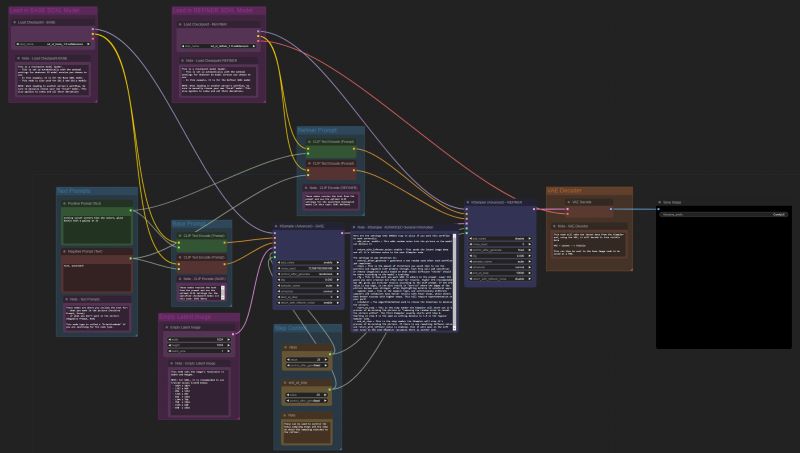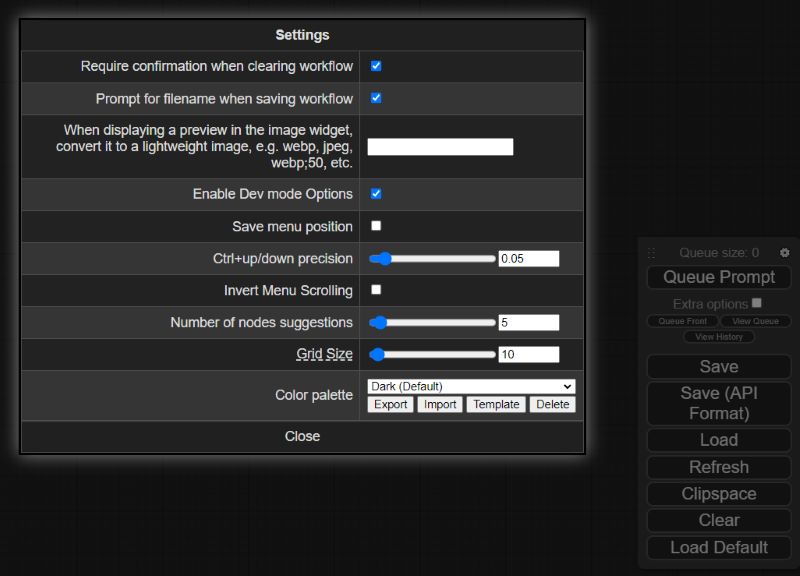The ComfyUI-to-Python-Extension is a powerful tool that translates ComfyUI workflows into executable Python code. Designed to bridge the gap between ComfyUI's visual interface and Python's programming environment, this script facilitates the seamless transition from design to code execution. Whether you're a data scientist, a software developer, or an AI enthusiast, this tool streamlines the process of implementing ComfyUI workflows in Python.
Convert this:
To this:
import random
import torch
import sys
sys.path.append("../")
from nodes import (
VAEDecode,
KSamplerAdvanced,
EmptyLatentImage,
SaveImage,
CheckpointLoaderSimple,
CLIPTextEncode,
)
def main():
with torch.inference_mode():
checkpointloadersimple = CheckpointLoaderSimple()
checkpointloadersimple_4 = checkpointloadersimple.load_checkpoint(
ckpt_name="sd_xl_base_1.0.safetensors"
)
emptylatentimage = EmptyLatentImage()
emptylatentimage_5 = emptylatentimage.generate(
width=1024, height=1024, batch_size=1
)
cliptextencode = CLIPTextEncode()
cliptextencode_6 = cliptextencode.encode(
text="evening sunset scenery blue sky nature, glass bottle with a galaxy in it",
clip=checkpointloadersimple_4[1],
)
cliptextencode_7 = cliptextencode.encode(
text="text, watermark", clip=checkpointloadersimple_4[1]
)
checkpointloadersimple_12 = checkpointloadersimple.load_checkpoint(
ckpt_name="sd_xl_refiner_1.0.safetensors"
)
cliptextencode_15 = cliptextencode.encode(
text="evening sunset scenery blue sky nature, glass bottle with a galaxy in it",
clip=checkpointloadersimple_12[1],
)
cliptextencode_16 = cliptextencode.encode(
text="text, watermark", clip=checkpointloadersimple_12[1]
)
ksampleradvanced = KSamplerAdvanced()
vaedecode = VAEDecode()
saveimage = SaveImage()
for q in range(10):
ksampleradvanced_10 = ksampleradvanced.sample(
add_noise="enable",
noise_seed=random.randint(1, 2**64),
steps=25,
cfg=8,
sampler_name="euler",
scheduler="normal",
start_at_step=0,
end_at_step=20,
return_with_leftover_noise="enable",
model=checkpointloadersimple_4[0],
positive=cliptextencode_6[0],
negative=cliptextencode_7[0],
latent_image=emptylatentimage_5[0],
)
ksampleradvanced_11 = ksampleradvanced.sample(
add_noise="disable",
noise_seed=random.randint(1, 2**64),
steps=25,
cfg=8,
sampler_name="euler",
scheduler="normal",
start_at_step=20,
end_at_step=10000,
return_with_leftover_noise="disable",
model=checkpointloadersimple_12[0],
positive=cliptextencode_15[0],
negative=cliptextencode_16[0],
latent_image=ksampleradvanced_10[0],
)
vaedecode_17 = vaedecode.decode(
samples=ksampleradvanced_11[0], vae=checkpointloadersimple_12[2]
)
saveimage_19 = saveimage.save_images(
filename_prefix="ComfyUI", images=vaedecode_17[0]
)
if __name__ == "__main__":
main()
- Streamlining the process for creating a lean app or pipeline deployment that uses a ComfyUI workflow
- Creating programmatic experiments for various prompt/parameter values
- Creating large queues for image generation (For example, you could adjust the script to generate 1000 images without clicking ctrl+enter 1000 times)
- Easily expanding or iterating on your architecture in Python once a foundational workflow is in place in the GUI
- Use all the custom nodes!
- Custom nodes are now supported. If you run into any issues with code execution, first ensure that the each node works as expected in the GUI. If it works in the GUI, but not in the generated script, please submit an issue.
-
Navigate to your
ComfyUIdirectory -
Clone this repo
git clone https://github.com/pydn/ComfyUI-to-Python-Extension.git
After cloning the repo, your
ComfyUIdirectory should look like this:/comfy /comfy_extras /ComfyUI-to-Python-Extension /custom_nodes /input /models /output /script_examples /web .gitignore LICENSE README.md comfyui_screenshot.png cuda_mollac.py execution.py extra_model_paths.yaml.example folder_paths.py latent_preview.py main.py nodes.py requirements.txt server.py -
Navigate to the
ComfyUI-to-Python-Extensionfolder and install requirementspip install -r requirements.txt
-
Launch ComfyUI, click the gear icon over
Queue Prompt, then checkEnable Dev mode Options. THE SCRIPT WILL NOT WORK IF YOU DO NOT ENABLE THIS OPTION!
-
Load up your favorite workflows, then click the newly enabled
Save (API Format)button under Queue Prompt -
Move the downloaded .json workflow file to your
ComfyUI/ComfyUI-to-Python-Extensionfolder -
If needed, update the
input_fileandoutput_filevariables at the bottom ofcomfyui_to_python.pyto match the name of your .json workflow file and desired .py file name. By default, the script will look for a file calledworkflow_api.json. You can also update thequeue_sizevariable to your desired number of images that you want to generate in a single script execution. By default, the scripts will generate 10 images. -
Run the script:
python comfyui_to_python.py
-
After running
comfyui_to_python.py, a new .py file will be created in the current working directory. If you made no changes, look forworkflow_api.py. -
Now you can execute the newly created .py file to generate images without launching a server.

